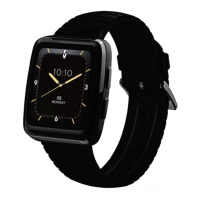Masmio W1 About This Manual
Masimo Corporation 4 www.masimo.com
About This Manual
This manual explains how to set up and use the Masimo W1™. Important safety information relating to general use of Masimo W1 appears in this manual. Read and follow
any warnings, cautions, and notes presented throughout this manual. The following are explanations of warnings, cautions, and notes.
A warning is given when actions may result in a serious outcome (for example, injury, serious adverse effect, death) to the patient or user.
WARNING: This is an example of a warning statement.
A caution is given when any special care is to be exercised by the patient or user to avoid injury to the patient, damage to this device, or damage to other property.
CAUTION: This is an example of a caution statement.
A note is given when additional general information is applicable.
Note: This is an example of a note.
Product Description and Features
Product Description
Masimo W1™ is a wearable device that continuously tracks health data to better understand your general state of health and promote healthier lifestyle decisions.
The Masimo W1 is compatible with the Masimo Health app where users can access, track and trend their health data.
Features
Key features of Masimo W1 include:
• Masimo SET+™ technology.
• Bluetooth® LE for the wireless communication.
The Masimo W1™ provides these measurement features:
Oxygen Level (SpO
2
) *
Oxygen levels in your blood, which can change with heart and lung function, activity, and altitude.
Pulse Rate (PR)
How often the heart pushes blood through your body, which can change with general health, physical activity, and with your mental or emotional state (e.g., stress, anxiety).
Pulse Rate Variability
(PRV)
The changes in your pulse rate that can show how consistently your blood is being pushed through your body even under exercise or stress.
Pleth Variability Index
(PVi)
A calculation based on the changes in your perfusion index, which may be affected by your fluid volume during your respiration cycle and can increase with lower fluid
levels.
Perfusion Index (Pi) A calculation of the relative strength of your pulse, which changes based on your circulation. The changes in your pulse rate that can show how consistently your blood is
being pushed through your body even under exercise or stress.
Heart Rate (HR) The number of times the heart beats in a minute, based on electrical signals.
Heart Rate Variability
(HRV)
Variations in the amount of time between heart beats, which may provide insight in how consistently your reacting to changes that affect your heart rate like exercise or
stress.
Breaths Per Minute
(RRp)
The number of breaths you take in a minute, based on the pleth; respiration rate can change with your general health condition, physical activity, or mental or emotional
state
* Arterial Oxygen Saturation

